#Pentameron
Explore tagged Tumblr posts
Text
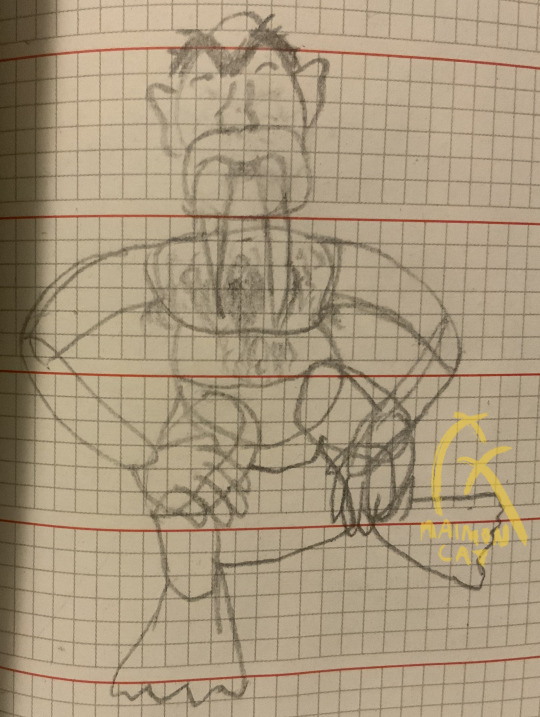
Another old sketch for #orctober
Back then I wanted to draw the ogre from the first story of Basile‘s “Tale of Tales” in this pose: “… where, at the entrance of a pumice cave, sitting on the root of a poplar tree, he found an ogre, and goodness gracious. Was he ugly! His head was larger than an Indian gourd, his forehead full of bumps, his eyebrows united, his eyes crooked, his nose flat, with nostrils like a forge, his mouth like an oven, from which protruded two tusks like unto a boar's ; a hairy breast had he, and arms like reels ; and bandy-legged was he, and flat-footed like a goose; briefly he was an hideous monster, frightful to behold, who would have made a Roland smile, and would have frightened a Scannarebecco ;” -Giambattista Basile, “The Tale of Tales”, translation based on that of sir Richard Francis Burton
Allora volevo provare a disegnare in questa posizione con la descrizione dell‘orco nella prima fiaba de “Lo cunto de li cunti” di Basile:
“Colà, sulla radice di un pioppo, presso una grotta lavorata di pietra pomice, era seduto un orco: o mamma mia, quanto era brutto! Era nano e sconcio di corpo, aveva il capo più grosso d’una zucca d’india, la fronte bernoccoluta, le soprac- ciglia congiunte, gli occhi stravolti, il naso schiacciato, con due narici che parevano due chiaviche maestre; una bocca quanto un palmento, dalla quale uscivano due zanne che gli giungevano ai malleoli; il petto peloso, le braccia di aspo, le gambe piegate a vòlta, e i piedi larghi di papera. Insomma, pareva un diavolo, un parasacco, un brutto pezzente e una mal’ombra spiccicata, che avrebbe sbigottito un Orlando, atterrito uno Scannarebecco, e fatto cadere in deliquio il più abile schermitore.” -Giambattista Basile, “Il Pentamerone ossia La Fiaba delle Fiabe”, traduzione di Benedetto Croce
Damals wollte ich versuchen, den Wilden Mann aus Basiles „Märchen der Märchen“ in dieser Position zu zeichnen: „Hier sah er auf dem Stumpf einer Pappel neben einer Grotte aus Bimsstein einen wilden Mann sitzen. O steh mir bei, wie häßlich sah der aus! Er war ein ganz kleiner Knirps und nicht größer als ein Zwerg; er hatte aber einen Kopf, dicker als ein indischer Kürbis, eine blättrige Stirn, die Augenbrauen zusammengewachsen, verdrehte Augen, eine platte Nase mit zwei Nasenlöchern, die zwei Kloaken schienen, einen Mund so groß wie eine Kelter, aus welchem zwei Hauer hervorragten, die ihm bis an die Fußspitzen gingen, eine zottige Brust, Arme wie eine Garnwinde, Beine wie eine Bogenwölbung und Füße so flach wie die einer Gans; mit einem Wort, er schien ein Popanz, ein Teufel, ein häßliches Fratzengesicht und ein wahres Schreckgespenst, das selbst einen Roland hätte in Angst setzen, einem Achilles den Mut rauben und einen Bettelbruder abschrecken können.„ - Giambattista Basile, „Das Pentameron”, übersetzt von Felix Liebrecht
#orc#orco#ogre#uerco#fairy tales#folk tales#folklore#my artwork#my art#old art#sketch#sketchbook#pentamerone#tale of tales#lo cunto de li cunti#Il racconto dei racconti#Das Märchen der Märchen#Pentameron#wild man#wilder mann#october#orctober
3 notes
·
View notes
Note
I was watching Roberto de Simone's musical from 1976 with my mum, which adapts Basile's La gatta Cenerentola (the cinderella cat), from the Pentameron; and we came to the song of the six sisters, so I tried to see the meaning of their names, since the play kept them mostly the same as the tale:
Patrizia: "noble". Her name was changed from Colommina, a neapolitan form of Colombina, meaning "little dove". De Simone likely changed it due to Colombina being the mask of the witty servant girl in the Commedia dell'arte.
'Mperia: a dialectal form of Imperia, meaning "empire"
Calamita: "magnet"
Diamante: "diamond"
Sciurella (Shiorella in the Pentameron): a dialectal form of Fiorella, meaning "little flower"
Pascarella: a dialectal form of Pasqualina, meaning "of Easter", often used for girls born on Easter.
(I wrote them down here in the order that the stepmother calls them in the play. In Basile's fairy tale the order is ’Mperia Calamita Shiorella Diamante Colommina Pascarella)
This… out of curiosity
Do you know the different meanings of the name of Cinderella's Stepsisters?
Charles Perrault's Cendrillon
Javotte: A nickname for Geneviève, which means "of the race of woman," "woman of the family," or "white wave."
(Perrault only reveals the older stepsister's name in one scene, not the younger one's.)
Rossini's opera La Cenerentola
Clorinda: “Youthful” or “greenery.”
Tisbe: Unknown; it’s a name from Greek mythology.
Massenet's opera Cendrillon
Noémie: “Pleasantness.”
Dorothée: “Gift from God.”
The 1947 Russian film
Anna: “Grace” or “favor.”
Marianna: A cross between Mary, meaning “bitter,” “drop of the sea,” or “beloved,” and Anna (see above).
The Let's Pretend radio adaptation
Flora: “Flower.”
Isabella: A form of Elizabeth, meaning “My God is an oath.”
The Disney version, animated and live action
Anastasia: “Resurrection.”
Drizella: Probably a variant of Drusilla, meaning “little strong one.”
The 1955 film The Glass Slipper
Birdena: “Little bird.”
Serafina: “Fiery one.”
The 1957 version of Rodgers and Hammerstein's musical
Portia: “Pig.”
Joy: Self-evident.
The 1965 version of Rodgers and Hammerstein's musical
Prunella: “Little plum.”
Esmeralda: “Emerald.”
The Muppets' Hey, Cinderella!
Mona: “My lady.”
Lisa: Derived from Elizabeth, meaning “my God is an oath.”
Rankin/Bass's Festival of Family Classics
Fatima: “To abstain” (though it serves as a play on “fat,” because she is fat)
Leania: Probably derived from Helen, meaning “light” (though it serves as a play on “lean” because she’s scrawny)
The 1969 Czech film
Katerina: “Far off” or “pure.”
Dorota: "Gift from God."
The 1973 Czech film Three Wishes for Cinderella
Dora: “Gift.”
The 1976 film The Slipper and the Rose
Isobella: “My God is an oath” (see above).
Palatine: “Of the palace.”
The 1978 African-American adaptation Cindy
Olive: "Olive," of course.
Venus: "Love."
The Faerie Tale Theatre adaptation
Arlene: “Honor” or “eagle.”
Bertha: “Bright.”
The Grimm's Faerie Tale Classics adaptation (English dub)
Phoebe: “Bright.”
Griselda: “Gray battle.”
Stephen Sondheim's musical Into the Woods
Florinda: "Flower."
Lucinda: "Light."
The Happily Ever After: Fairy Tales for Every Child adaptation
Margarita: “Pearl” or “daisy flower.”
Esmeralda: “Emerald” (see above).
The musical A Tale of Cinderella
Moltovoce: “Much voice.”
Seppia: “Squid.”
The 1996 Burbank Animation version
Nellie: A nickname for Ellen or Helen, meaning “torch” or “light.”
Melba: Derived from Melbourne, Australia. Melbourne means “mill stream.”
(Their names are inspired by the famous Australian opera singer Nellie Melba, whose birth name was Helen Mitchell and who took her stage name from her home city of Melbourne.)
The anime series Cinderella Monogatari
Catherine: “Far off” or “pure.”
Jeanne: “God is gracious.”
The 1997 version of the Rodgers and Hammerstein musical
Minerva: “Intellect.”
Calliope: “Beautiful voice.”
The 1998 film Ever After: A Cinderella Story
Marguerite: “Pearl” or “daisy flower.”
Jacqueline: “Heel-grabber” or “supplanter."
Gregory Maguire's novel Confession of an Ugly Stepsister
Iris: "Rainbow" or "iris flower."
Ruth: "Friend."
Margaret Peterson Haddix's novel Just Ella
Griselda: "Gray battle" (see above).
Corimunde: Possibly a variant of "Clarimond," meaning "shining defender."
The Shrek franchise
Doris: "Dorian woman."
Mabel: "Lovable."
The 2000 stage version of the Rodgers and Hammerstein's musical
Grace: Self-evident.
Joy: Self-evident (see above).
The 2000 British TV film
Goneril: Unknown meaning.
Regan: "Little ruler" or "king's child."
(In case anyone didn't know it, their names are taken from the evil sisters in Shakespeare's King Lear.)
The Simsala Grimm adaptation
Agatha: “Good.”
Beatrice: "One who blesses.”
The novel and film Ella Enchanted
Hattie: A nickname for Harriet, meaning “home ruler.”
Olive: Self-evident (see above).
The 2004 film A Cinderella Story
Brianna: "High" or "noble."
Gabriella: "God is my strength."
Malinda Lo's novel Ash
Ana: "Grace" or "favor" (see above).
Clara: "Clear" or "bright.
The 2010 Märchenperlen adaptation
Clothilde: “Glorious battle.”
The 2011 Sechs auf einen Streich adaptation
Annabella: "Grace and beauty."
The 2013 stage version of the Rodgers and Hammerstein musical
Gabrielle: “God is my strength” (see above).
Charlotte: “Free woman.”
Alma Deutscher's opera
Griselda: “Gray battle” (see above).
Zibaldona: Possibly derived from Zebada, which is derived from Zebadiah, meaning “God has bestowed.”
Betsy Cornwell's novel Mechanica
Piety: Self-evident.
Chastity: Self-evident.
Andrew Lloyd Webber's musical Bad Cinderella
Adéle: “Noble.”
Marie: “Bitter,” “drop of the sea,” or “beloved.”
The 2021 Sony/Amazon film
Narissa: “Sea nymph.”
Malvolia: “Ill will.”
#cinderella#fairy tale#cinderella's stepsisters#name meanings#fairy tales#La gatta cenerentola#cenerentola#reblog#Pentameron#Pentamerone
31 notes
·
View notes
Note
What are your thoughts on "The Young Slave" from The Pentamerone?
Ah, the same way I feel about most stories from the Pentamerone: very grateful that we still have it, as a part of fairy tale history, without exactly liking it.
The Pentamerone (by Giambattista Basile, published posthumously in 1634/1636) is an incredibly important collection, but the tales are rather brutal. "The Young Slave" is no different. Basile's collection of Neapolitan fairy tales contains the oldest known literary version of many very well-known fairy tales. In the case of "The Young Slave" the story of Snow White. While it also contains elements that are more well-known for showing up in different fairy tales. For example:
• The beautiful protagonist, Lisa, was born because her mother swallowed a rose petal. This motif shows up in various Spanish, Portugese and Scandinavian folktales.
• Lisa is blessed by two fairies and cursed by a third to die prematurely, similar to Sleeping Beauty. (Though the fairy is not an unwanted guest, or inherently evil, she speaks in anger because she twists her ankle.)
• Because of the curse Lisa gets a comb stuck in her hair, which poisons her, and is put in seven crystal coffins and hidden away. While there is no evil queen, this does have similarities with Snow White.
• Lisa's mother firbids her brother, the baron, to open the room with the coffin and dies. Years later his wife discovers the coffin, however, and Lisa has by then aged into a beautiful young woman. The jealous woman drags her out by her hair, knocking the comb loose and waking her up. This reminds me more of Gold Tree and Silver Tree which is itself often named as a Snow White variant.
• Lisa's jealous aunt now takes the role of evil stepmother, dresses and treats her as a slave and abuses her. Much like various versions of Snow White.
• One day the baron goes to a country fair and asks everyone his household what thing they would like him to bring for them, even the slave girl, despite his wife's anger. Lisa asks for a doll, a knife, and some pumice-stone, and adds that if he forgets to bring them, he will not be able to cross the river. This reminds me of some versions of Beauty and the Beast and Russian tales like Finist the Falcon, where a merchant father brings the youngest daughter an inexpensive but very significant gift.
• Lisa can make the doll talk to her by threatening self harm and tells it her sad life story. (I mostly know magical dolls from Slavic and Chinese fairy tales, but that might be lack of further reading on my part). The baron overhears her talking and realises what his wife has done. The motif of telling your misfortune to an object and being overheard shows up in tales like the Goose Girl, The Ghoulish Schoolmaster and the Stone of Pity, and more notably The Maiden with the Rose on her Forehead (which is likely a more direct descendant of The Young Slave than Snow White is.)
• The baron sends Lisa to relatives to recover and then invites her back home for a splendid banquet, where she tells everyone how she was treated by the baroness. The baron banishes his wife (which is surprisingly merciful) and finds a worthy husband for Lisa whom she loves. This big reveal at a banquet shows up in various stories, like true bride/forsaken fiancée stories, or variations on The Cruel Sister.
To me the most interesting element of this story, apart from it's very different beginning, is that Lisa's uncle is so instrumental, while her future husband is only mentioned in the very last line. In most folktales with an abusive wife, the husband is notably bad at doing anyting about her cruelty. So this makes a nice change!
#I have the Pentamerone#I have not once been able to read it all the way through#the young slave#italian folklore#laura babbles
26 notes
·
View notes
Text
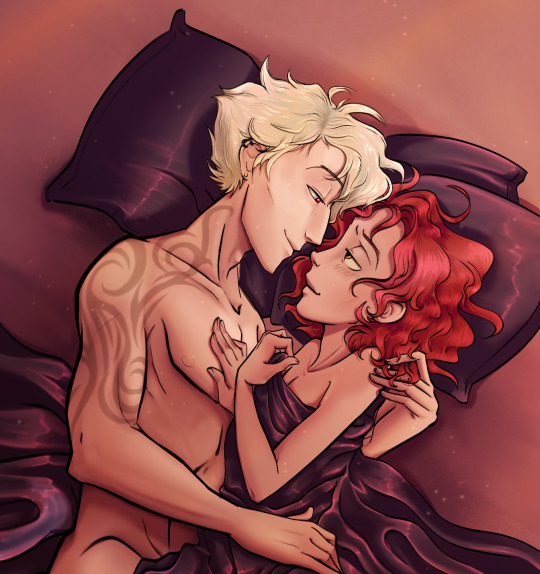
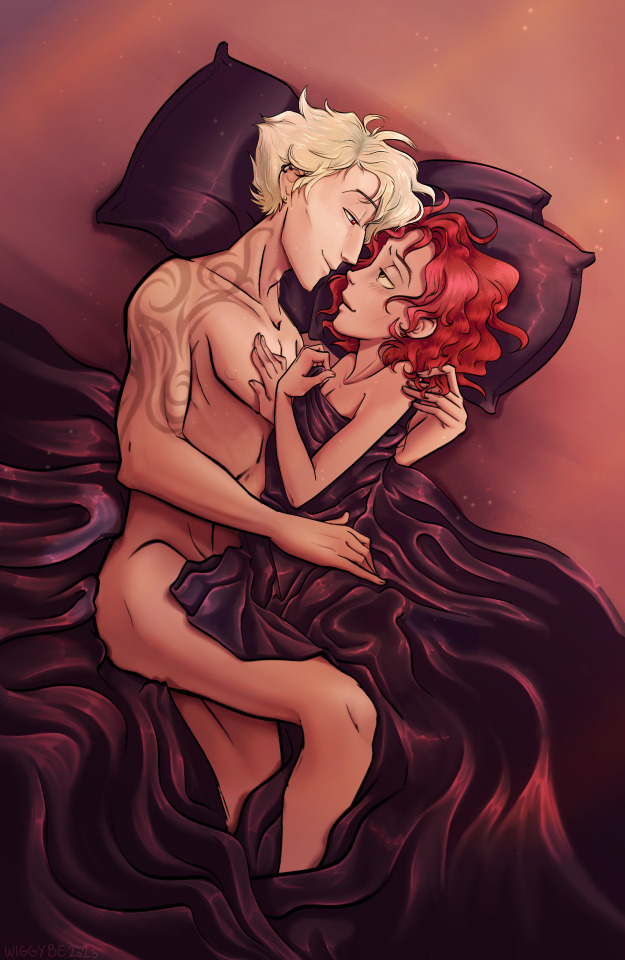
A birthday gift I did for @ilpentamerone of a couple of some very in-love OC's together. I'm really pleased how this turned out, particularly the shading/colours.
(I take OC commissions, hmu if you're interested.)
#wiggy#wiggybe#ilpentamerone#pentamerone#original characters#oc's#romance#bed#bedsheets#romantic#couple#love#relationship#Charlie#foster#birthday gift
15 notes
·
View notes
Text



༻✦༺ Petrosinello ༻✦༺
A gay reimagining of "Petrosinella" (a Rapunzel's variant) featuring Emanuele Mariotti as Petrosinello (Rapunzel's counterpart), Alberto Malanchino as the Prince and Pierfrancesco Favino as the Ogre (Mother Gothel, basically).
✧・゚: ✧・゚: :・゚✧:・゚✧✧・゚: ✧・゚: :・゚✧:・゚✧✧・゚: ✧・゚: :・゚✧:・゚✧ :・゚✧:・゚
"Petrosinella" (Little Parsley) was written in Neapolitan by Giambattista Basile and he included it in his 1634 collection of fairy tales "The Tale of Tales." It is an Aarne–Thompson type 310 "the Maiden in the Tower" tale, as well as the earliest recorded variant of "Rapunzel." The Brothers Grimm's more famous version was published almost two centuries later, in 1812.
You can read an English translation of "Petrosinella" here.
✧・゚: ✧・゚: :・゚✧:・゚✧✧・゚: ✧・゚: :・゚✧:・゚✧✧・゚: ✧・゚: :・゚✧:・゚✧ :・゚✧:・゚
Here you can find the whole list of my Gay Tales!
#fairy tales#gay fairy tales#gay tales#petrosinello#petrosinella#giambattista basile#the tale of tales#lo cunto de li cunti#pentamerone#rapunzel#brothers grimm#emanuele mariotti#alberto malanchino#alberto boubakar malanchino#pierfrancesco favino#moodboard#aesthetics
30 notes
·
View notes
Text
I really liked this series of reviews, so I wanted to add something: there is actually an earlier attempt of adapting the Pentameron into film. It's the 1967 movie "C'era una volta" by director Francesco Rosi. This one's important to me, since it was one of my first encounters with Basile's work.

It was released in France as "la belle et le cavalier", in Germany as "Schöne Isabella" and in english speaking countries as "More than a miracle", "Cinderella italian style" and "Happily ever after", and starred Omar Sharif as Prince Rodrigo and Sophia Loren as isabella da Candeloro. The movie did not get that much success, partly also because italian cinema was very adverse to the fantastical. Producer Carlo Ponti's modifications to what Rosi and the writers had in mind have also been accused of damaging the final product.
Rather than trying to adapt one or more tales from the Pentameron, Rosi tried to invoke this book's style of humour (though it has less enjoyment of the grotesque), while writing it's own, (somewhat) original story. The plot follows the two leads meeting per chance, bickering their way into falling in love and face hardships in trying to get together. It features elements from various tales of the Cunto de li Cunti, like the gold-shitting donkey from "the Ogre", the punishment of the barrel from "the three cedars" and the wine fountain, as a twist on the introductory tale, but it adds pieces from other south-italian folk tales and legends, like the witches' sabbath under the Nuttree of Benevento and the life of st. Joseph of Copertina.
Beside the general style, "More than a Miracle" differentiates itself from "Tale of tales" with its local nature. I already mentioned how it fishes from south italian folk lore for plot points, but the story really is set in that region. The spanish rule over the South is brought up again and again: the heir to the Kingdom of Naples is pressured into marrying a spanish princess and Isabella has to hide him when he gets lost in the countryside, since her fellow villagers would want to take him out [EDIT: I misremembered that scene. She hides him because she thinks he stole the prince's horse ("so you really are a thief, just like all you spaniards!") and fears the retaliation of the spanish guards]; Most characters speak with thick neapolitan accents; the giant omelette for the feast is based on a real event that happened in 1535 in one of the castles used to shoot the film. Garrone's movie is very international, the settings are Basile's imaginary kingdoms, the characters speak italian correctly (in the italian dub) and Violet listens to the story of Lancelot and Guinevere, which is and arthurian plot point enjoyed throughout most of Europe. The south-italian locations don't have the same involvement as in "More than a miracle". Rosi's wanted to even cast the iconic italian comedian Totò as Joseph of Copertina, but Carlo Ponti refused because he wasn't famous enough abroad.
There is so much to be said about thus film, and it is one of my favourites, but it is better if I stop here.
Good night!
The Tale of Tale movie analysis (1)
It has been a long time since I did a fairytale movie analysis, and for this month I want to take a look at a movie that has been asked of me before, a long time ago: "Tale of Tales".
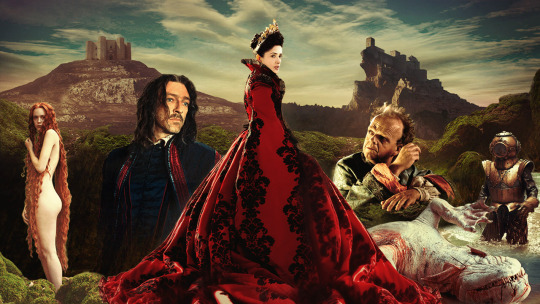
For those of you who do not know about this movie, "Tale of Tales" is a 2015 movie, a "European production" (it is an Italian movie, but it received help and collaboration from France and England, hence the "European" etiquette) that is to this day (and to my knowledge) the only movie that adapts Basile's Pentamerone, the titular "Tale of Tales".
The Pentamerone being one of the two foundational works when it comes to literary fairytales, and one of the two great books of classical Italian literary fairytales alongside Straparole's Facetious Nights. Basile's book is very famous for containing some of the earlier literary records of fairytale types such as Rapunzel, Sleeping Beauty, The Girl Without Hands, and more.
The book contains a total of fifty stories, and of course the movie couldn't adapt them all, so it was decided to only adapt three in total. The three chosen are usually considered emblematic stories of the Pentamerone - but they were also selected because they do not echo the more well known Grimm stories. The three selected were, The Flea, The Enchanted Doe, and The Flayed Old Lady - all taken from the first part of the book.
Note that this movie was greatly acclaimed for its extensive use of practical special effects - and there is one thing you cannot deny this movie, it looks absolutely incredible. There is a great effort on the visuals ranging from selected architecture and landscape to careful costume crafting and delightful monsters on screen.
Before going into the analysis of each of the fairytales of the movie, I wanted to point out a few things covering the entirety of the movie. Three details to be exact.
Matteo Garrone, when doing this movie, didn't just randomly selected three stories that were to his fancy. He chose three specific stories that he then tied together with cohesive themes and motifs. The first of which, the most prominent, being "obsession". Each segment is about presenting the obsessions of specific characters, and the bad outcomes of it.
The other shared motif between the three fairytales is "the ages of a woman". Despite the movie having as much male as female characters, Garrone explained very clearly that this movie was about the women, not the men, and that each fairytale represented one of the traditional three "ages of woman". "The Flea" becomes the Maiden story, focusing on the young princess ; "The Enchanted Doe" becomes the Mother story, with an exploration of the character of the queen, while "The Flayed Old Lady" is of course the Crone tale.
But much more importantly for us to understand this movie: Matteo Garrone did one very heavy and important change compared to the original material. The tone. The tone is radically different. Basile's original book, just like Straparole's fairytales, worked by the specific nature of these Italian literary fairytales of the time: they were grotesque farces, and vulgar jokes. In my last post about the Pentamerone I compared these stories to a Brandon Rogers video, because Basile's stories, despite being the ancestors of the Grimm or Perrault fairytales, are nothing like the modern fairytales we are today. They are sex stories filled with caricatures, they are gruesome, gory stories filled with morally-gray characters, they are one huge dark joke filled with poop and farts and vulgar allusions. They are much closer to medieval tales and to the tone of a Reynard the Fox story or some Rabelais books than any other fairytales we know today. But Garrone decided to apply a principle that you can see explored in series such as "Horace and Pete" or "Kevin can fuck himself". Take a sitcom, remove the laugh-track, you have a tragedy. Garrone's movie is still as grotesque as the original stories - but now the jokes are put aside, the most vulgar parts removed, the sex and the gore examined for what it is under a realistic eye. This "realistic", and "non-comical" treatment of the stories make this world of grotesque caricatures and senseless violence and depraved debauchery one not of marvels and fairies, but one of tragedies, of abuse, of horror. But, tragedies with magic, abuse with beauty, horror with happy and hopeful endings - because they stay fairytales after all, no matter how dark they are. Mean, cruel, sad fairytales, but fairytales nonetheless.
[Trivia: The fact that Basile's work was a very rude, crude and vulgar piece of sex-and-violence that can only be compared to Rabelais meeting Punch & Judy, is something many people in the English-speaking world completely missed because the first real popular and widespread translations of the text in English, in the... I think it was the 19th century or maybe a bit earlier ; but these versions were heavily censored. Trying to make the story more like a Perrault or d'Aulnoy tale, they removed many sex references, remove all the poop jokes, and even cut off some stories deemed too vulgar ot gruesome, so that for a very long time people thought they were supposed to be... regular fairytales. This is especially relevant with "Thalia, the Sun and the Moon", Basile's "Sleeping Beauty" variant. Many people point out that the girl in this story gets raped by the prince and that this shows how the fairytale of Sleeping Beauty was built on a glorification of rape, because it is treated as ormal or as some romance. But... no. This rape is treated as a rape and the prince is very clearly a lustful asshole who is taking advantage of the girl - because it is a dark sex-tale. Princes in the Pentamerone are almost all lustful rapists, violent murderers or complete helpless idiots, because the Pentamerone does not work on a "prince charming" logic. Take "The Golden Root" - the handsome, kind, gentle, good prince that seems to fit the bill of the Prince Charming... is part of a family of ogres, and ends up murdering in rage his intended fiancée just to be married to the heroine of the tale. And that's something that many people missed for a very long time - the prince charming archetype is from the French tales of the 17th and 18th century, not before.]

#tale of tales#fairytale movie#pentamerone#italian fairytales#c'era una volta#C'era una volta (1967)#More than a miracle#Schöne Isabella#Cinderella italian style#happily ever after#italian movies#Lo cunto de li Cunti#La belle et le cavalier#pentameron#fairy tales
53 notes
·
View notes
Text
having an absolutely normal day at work where I’m “supervising” aka getting paid more money than usual to sit in the back and exchange giddy infodumps about fairytales, opera, and overlooked 90s female fantasy authors with my older sister
#me#sister story#I should be doing homework but I’m thinking about il Pentamerone and the love for three oranges again
2 notes
·
View notes
Link
Se vuoi leggere l'intera trascrizione della storia e scaricarla in formato PDF vieni a far parte dei nostri Patreon dal livello Cappuccino: https://www.patreon.com/AllyoucanItaly IL PENTAMERONE DI GIAMBATTISTA BASILE LO SCARAFAGGIO, IL GRILLO E IL TOPOLINO Nardiello era un giovane un po' strano. Suo padre, sperando di farlo diventare un bravo commerciante, gli diede cento ducati e lo mandò a fare affari. Ma Nardiello, invece di comprare qualcosa di utile, spese tutti i soldi per comprare tre animaletti: uno scarafaggio, un topo e un grillo. Quando tornò a casa senza un soldo e con tre insetti in tasca, suo padre si arrabbiò moltissimo e lo cacciò di casa. Nardiello se ne andò per la sua strada, insieme ai suoi strani amici. Dopo molte avventure, arrivò al castello di un re. La figlia del re era malata e nessuno riusciva a curarla. Nardiello, grazie ai suoi animaletti, riuscì a guarire la principessa. Il re, molto grato, decise di dargli in sposa sua figlia. Così, Nardiello, che era partito di casa senza un soldo e con tre insetti, finì per sposare una principessa e vivere felice e contento.
#allyoucanitaly#audiolibri#audiostorie#audiostorieinitaliano#basile#culturaitaliana#favoleitaliane#fiabeitaliane#italian#italianaudiobooks#italianaudiostories#italianlanguagepodacast#italianpodcast#learnitalianlanguage#learnitalianpodacast#narratoreitaliano#pentamerone#podcast#podcastdiitaliano#podcastitaliani
0 notes
Text


Warwick Goble Lacquer Box
#this sent me down the rabbit hole of researching what a lacquer box is#super interesting craft#I would love to own one someday#warwick goble lacquer box#finds#ebay#Rita riding on Dolphin Storie Pentamerone#fantasy art#fantasy lacquer box#vintage art
1 note
·
View note
Text
I do love how the Pentamerone was originally such a crass and violent work - and yet thanks to the spread of censored version in England we end up with such beautiful and delicate illustrations
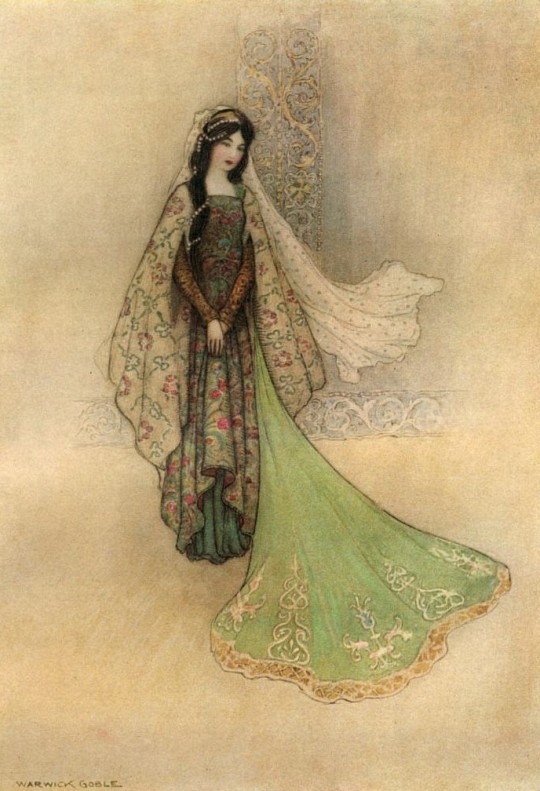

Illustrations from The Pentamerone by Warwick Goble (1911)
2K notes
·
View notes
Text












(a cura di) Antonella Castello L'ALTRA META' DELLE FIABE 2016 ABEditore
1 note
·
View note
Note
Regarding your Cinderella posts, I would even say that in Pentamerone's 17th Century's version, the Prince makes this thing of inviting the ladies to court to try the shoe iirc, and when Basile's heroine Zezolla arrives I think the shoe magically flies to her foot? I cant remember if this last part comes from Pentamerone.
Oh yes, this is all true! I had forgotten, since it's been about a year since I last read that story.
2 notes
·
View notes
Text
As I have been reblogging and looking back at Sleeping Beauty stuff around the Internet, I realized the thing that is bothering me a bit... When it comes to the you know "original" format of Sleeping Beauty.
Everywhere on the Internet you have these posts and videos and whatnot about "The dark truth behind Sleeping Beauty" or "The Horrifying Origins of Sleeping Beauty!", and they all refer to the fact that in the "original" version of the tale, she got raped in her sleep. This is the "dark fact" everybody LOVES to spread around and talk about. Except... Except the version they refer to is Basile's "Sun, Moon and Thalia".
Why does that matter? I'll explain.
Everybody depicts "Sun, Moon and Thalia" as this sort of dark, horrifying tale of a grim and gruesome crime. They will have in their video a dark background, and creepy illustrations, and they will take an ominous horror movie voice and whatnot.
But there's a big problem with that. Basile's stories were all except serious. They were humoristic tales. Or more precisely, they were farcical stories. Farces. There's a reason its "twin compilation", Straparola's fairytale collection, is called "Facetious Nights". So the very idea of presenting these stories as if they were meant to be taken seriously is completely misreading the story's tone. Yes there was a rape - but if you extract this from the entire context and storytelling, you make this tale sound like something it is absolutely not.
"Sun, Moon and Thalia" is not meant to be a horror story. It was not meant to be read as "serious" story. It has nothing to do with either the Grimm or Perrault fairytales. The entirety of the "Pentamerone" is basically a folk-sex comedy. If such a thing can exist.
Every fairytale of the Pentamerone is opened by a small recap of the story announcing what it will be about - and already from the get-go the very two lines opening this recap give the humoristic nature of the tale away. "Thalia dies because of a splinter". I mean come on - the joke is obvious. A girl gets a splinter, she dies. And if this wasn't enough the rest of the sentence can be translated as following: "she is left in a room where the son of the king penetrates and makes her two children". The choice of the word "penetrate" is to highlight the pun in the original line where the prince entering Thalia's bedroom and the prince entering Thalia's body is resumed in one same verb.
For more breakdown of the jokes of the story, see below the cut:
As I said before from the get-go the "curse" is treated as a joke. You have this king that summons scholars to make his daughter's horoscope, right? And what does it say. "She is in great danger... BECAUSE OF A SPLINTER!". This is literaly the killer rabbit of the Monty Pythons.
In this story, what does the little old woman that offered the princess the spindle does, once the princess falls dead? (Because she is dead in this version, a magical death, but dead still). Does she warns everybody and cries for help as in Perrault's version? No! "She was quick to find back the stairs [from which she came in]" and she runs as fast away as she can without warning everybody, because she's not going to get into trouble because of some random girl that wanted to see how to spin.
The whole arrival of the prince is very, VERY unprincely and part of the joke. (Well it is a king here but I'm going to call him "prince" so as to not lose people). So he is hunting, right, and his hunting falcon enters the countryside building in which the king locked up his daughter's corpse. The prince wants to get back his bird, so he knocks - because he believes the house is inhabited. And since nobody answers and he REALLY wants his bird back, he fetches a ladder and is forced to climb up a window like a vulgar thief. And he is royalty, remember.
What is the prince's first interaction with the dead Thalia? Believing she is asleep, he starts talking to her. And since she doesn't answer he kind of shakes her around in trying to wake her up. And then suddenly, realizing she kind of looks good (an that she is visibly not alive anymore), he "does his little business" and promptly puts her back where he found her and leaves. Because he is, like most men in the Pentamerone a stupid horny dog without much morals that has the most sudden and bizarre bursts of sexual desire. Cause again the Pentamerone is a sex comedy.
In fact, in the story of "Sun, Moon and Thalia", the prince is MEANT to come off as quite stupid. He is stupid. First off he didn't get that Thalia was dead when he saw her. Then, as soon as he leaves the funeral-house, it is said he "forgot all about this adventure". Like literaly, he forgets all about it - and only suddenly remembers it randomly when Thalia wakes up. (The narration itself highlights the randomness of the events - the fact the prince remembers Thalia is random and for no reason, and in the same way there are two fairies that randomly appear out of nowhere to take care of the two babies and we are never explained anything about them - they even frighten poor awakened Thalia because she doesn't know who brings her magically food every day). When he sees back Thalia, he is all joyful and happy and he is like "Let's start a family! I'm a dad, woohoo!" ; and then the narration drops the bomb that nothing had foreshadowed: "Now, his wife was waiting for him back at the palace." The randomness of dropping the fact he has a wife is meant to be the joke, since we were led to believe he was a bachelor. But given the prince's tendency to forgetfulness it is very likely that he simply forgot he had a wife.
More of the prince's obvious stupidity and air-headedness. On one side how he betrays Thalia and her children's names to his wife - because he just can't stop repeating and singing their names out loud, day and night, even when eating or sleeping, due to how silly-happy he is. On the other, the reason why he is absent while his wife tortures Thalia: he got angry at a comment of hers, and because he was furious, he literaly had to go to ANOTHER LAND just to vent his anger. Literaly, he leaves his palace and moves to another of his domain just because he got pissy. And why did he get pissy? Because his wife kept ironically singing to him "Eat, because what you eat belongs to you" when she served him his "children" - and the stupid prince, unable to understand what she meant, literaly answers "Of course it belongs to me: I'm the bread-winner of the family, while you're doing nothing and bringing nothing to the house". [Which by the way, highlights the fact that in this couple, the wife is depicted as profiting off the king's wealth and power].
Speaking of the dinner around the fake "children": this meal is another sex joke. Because the two of them, the wife and husband, are "panting with desire" around the dishes, and keep singing stuff like "Oh that's good, oh that's good!" and "Come on, eat, come on eat!" making it all an erotic scene. A ridiculous, grotesque, perverse erotic scene around what one character believes to be a cannibalistic meal, while the other just very loudly appreciates good meat.
When the queen tries to have Thalia killed, Thalia tries to defend herself by the fact she didn't know of the queen's existence, and that any sexual thing that happened between her and the prince was in her sleep - which the queen of course does not believe because of how ridiculous it all seems. I mean you catch who you believe is your husband's lasting extra-marital mistress and what is her excuse? "Oh no you see, he made me my kids when I was asleep. Well kind of dead. I didn't know. No he did not wake me up. I didn't wake up either when the kids were born. I'm a really deep sleeper. And it was because of a splinter you see..." Literaly, imagine yourself in the place of the jealous queen hearing all that.
Thalia gains time on her execution by asking the permission to remove her clothes, and the queen accepts, but as a joke she accepts out of greed because she literaly wants to take back Thalia's dress and jewels for herself. And each time Thalia removes a piece of her clothes, she screams. She screams in hope of alerting the prince. But since the prince is far away, he doesn't hear until the very last scream. Meaning that Thalia literaly strips herself in front of the queen, while screaming every time she takes off a piece of clothing, to visibly no effect (which must leave the poor queen quite confused), and it is only when Thalia gets naked and pushes the final scream that the prince suddenly arrive. You can imagine Thalia going: "FINALLY! I've been screaming for hours now!" (especially when you consider how much pieces of clothing princesses wore at the time).
Literaly one of the threats the prince gives to his wife is "Get ready to go fatten up the broccolli". As a metaphor for being dead and buried underground. Tip-top manly threat. In fact the prince is here quite proficient in ridiculous poetic metaphors: when the cook reveals he saved his children, the prince says "Get ready to move out of the small kitchen of my castle to the vast kitchen of my heart."
And of course the final "moral" of the story is also part of the entire farcical joke that is this story. "People who are lucky receive good fortune, even in their sleep". You literaly have a girl who is randomly raped in her sleep and gives birth to children in her dead-sleep, and then is almost murdered by the rapist' wife... And THAT'S the moral of the story? If you take it all literaly, then you are a fool. Or at least Basile would have called you a fool.
Again, people tend to forget that when it comes to literary fairytales (but also a lot of folk-fairytales) there is a TONE that is important. It is the brothers Grimm and other collectors after them that imposed the idea that fairytales were meant to be read "seriously". A lot, LOT of fairytales were originally humoristic - even going into dark humor or sex comedy. And whenever you go by Straparola or Basile, you HAVE to look at them under the angle of a joke or humor, and search for the puns and caricatures and ridiculousness within these tales. Because these books were meant to be read as such. They are like Rabelais' Gargantua or Shakespeare's comedies. You can of course reinterpret them as "serious" tales... But it won't remove the fact the original was humoristic.
#sleeping beauty#dark fairytale#thalia the sun and the moon#sun moon and thalia#thalia sun and moon#basile#pentamerone#italian fairytales#fairytale history#humoristic fairytale#sex jokes#sexuality in fairytales
22 notes
·
View notes
Text

Warwick Goble (1862-1943), 'Grannonia and the Fox', ''Stories from the Pentamerone'' by Giambattista Basile, 1911 Source
#Warwick Goble#british artists#giambattista basile#vintage illustration#vintage art#color illustration#art nouveau
618 notes
·
View notes
Text
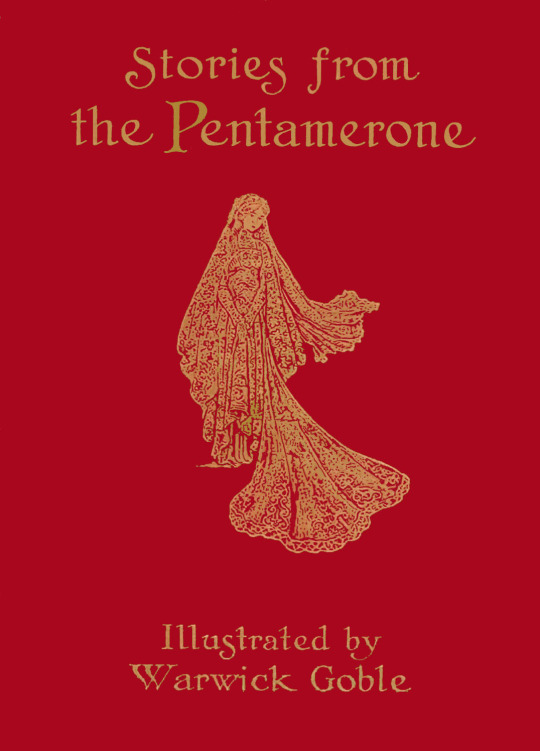
STORIES FROM THE PENTAMERONE by Giambattista Basile (1575-1632) (New York/London: Macmillan, 1911). Translated by John Edward Taylor (1847). Dozens of illustrations by Warwick Goble.

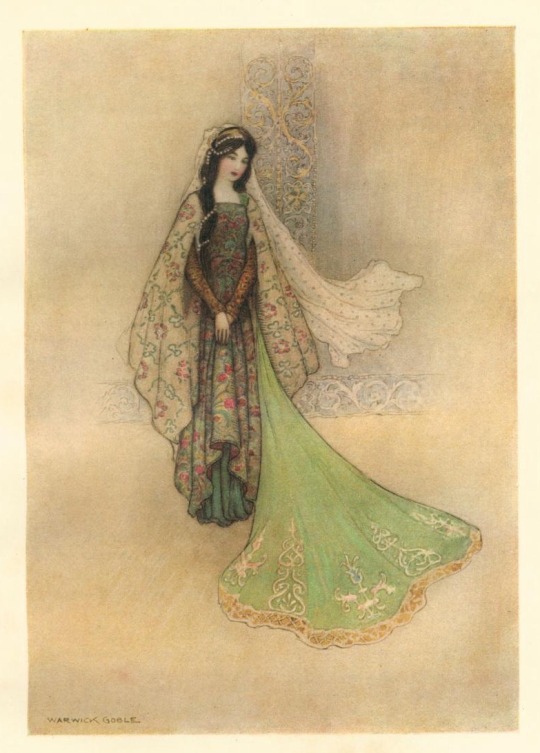
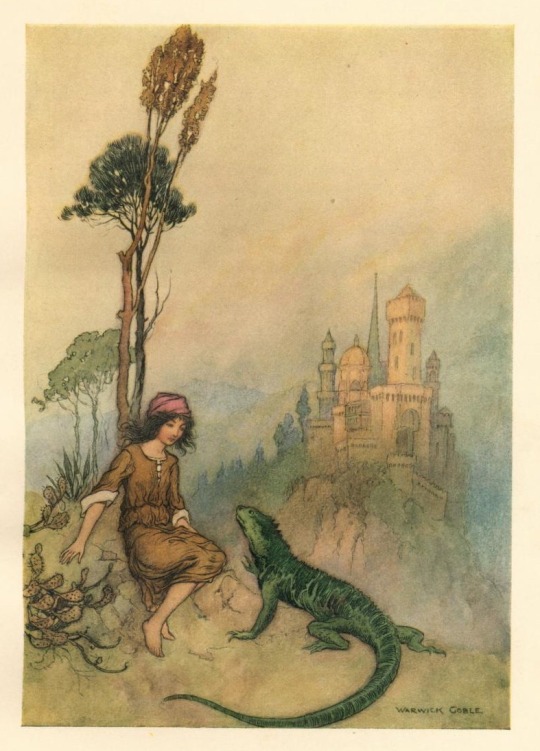
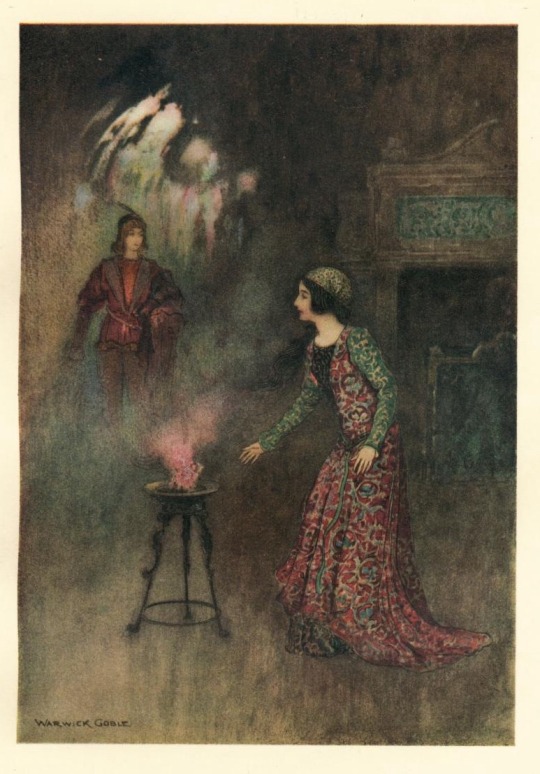
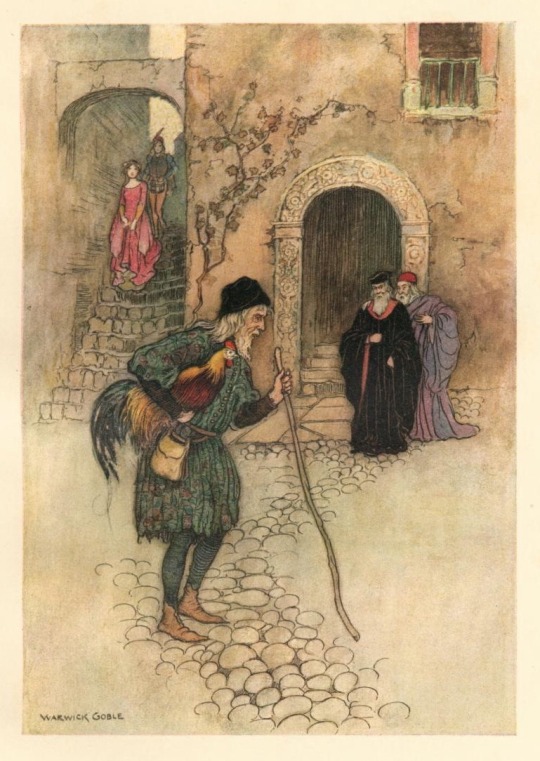
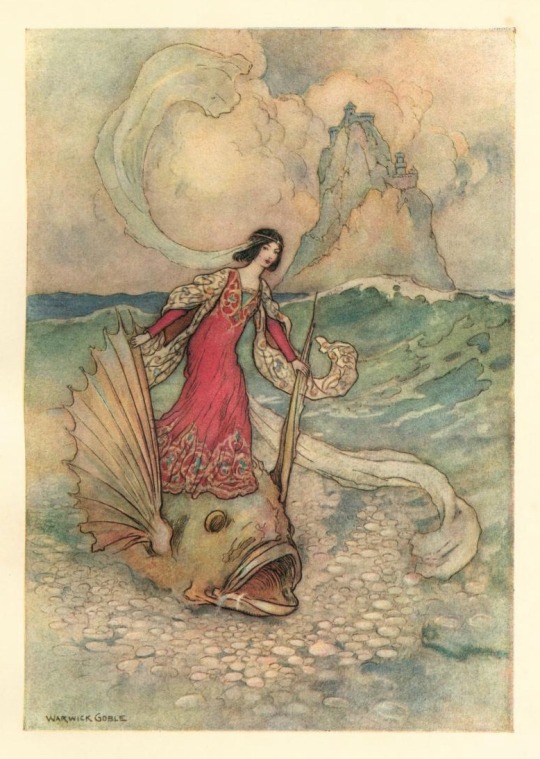
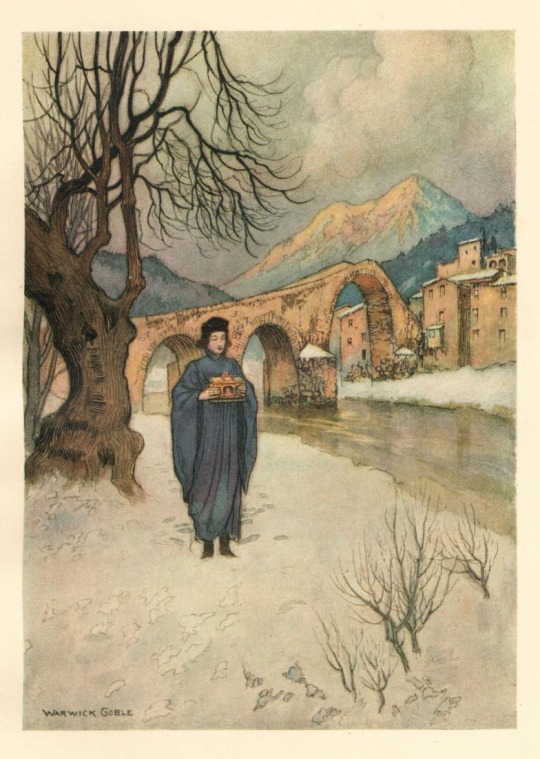
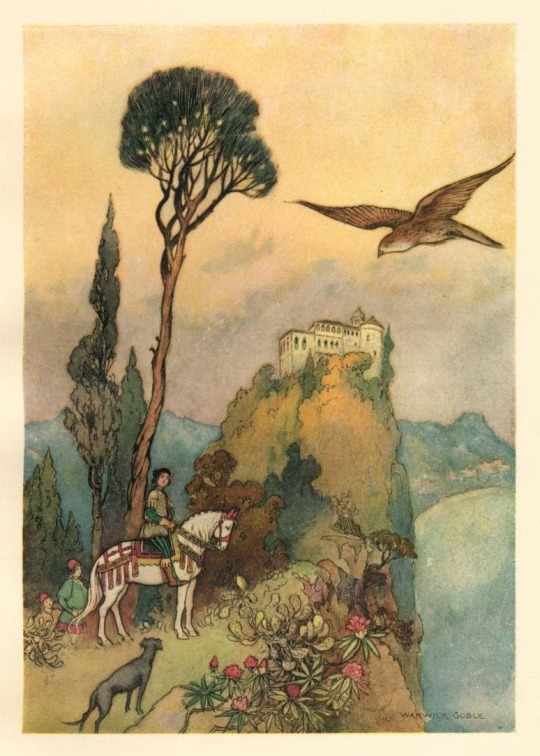
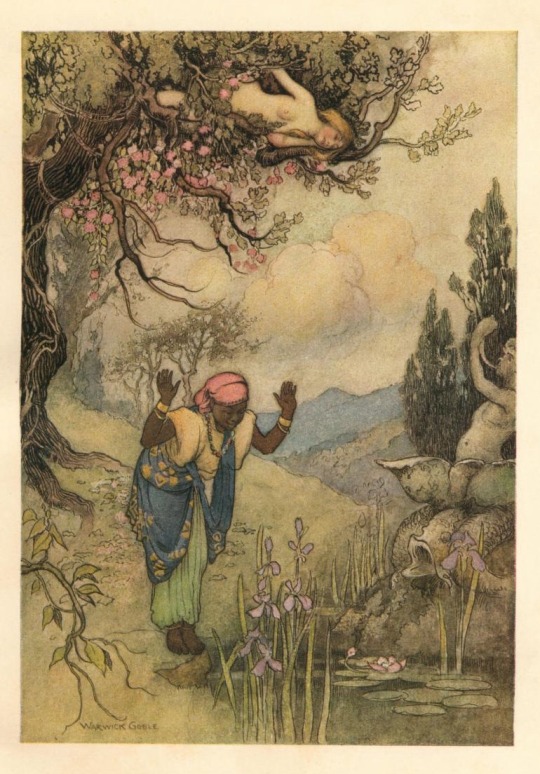
source
#beautiful books#book blog#books books books#book cover#books#vintage books#illustrated book#children���s book#book design#warwick goble#folk tales#italian folklore
66 notes
·
View notes
Text
Italian literature tournament - Sixth (and final) round - from Friday 27 December to Friday 3 January.

Edward Fairbrother Strange, Stories from the Pentamerone of Giambattista Basile, 1911, Macmillan editions.
👉 Merry Crasis and Merry Christmas dear followers! I hope you all have celebrated and enjoyed these days with your loved ones. 🎄 We've arrived at the end of our silly little tournament with the final round and the last three autors that will fight for their un-life beyond the grave thanks to. All. Of. You! 👈🎅👉
👉 As it's already explained here, one of the first problem that I occured was the organization of the challenge with that large number of names included and organizing in groups of 16 to permit the final round with a total face-to-face, but it was impossible, so the final round will see three partecipants, and a final podium (for the next edition, I'll try to create more specific and easily managerable tournaments).
👉 Since these days I'm very occupied not only with the holidays but also with work, at first I wanted to create the final round on a google form to let more time than a week (the maximum for a poll permitted by tumblr) and more easily to check things sometimes, considering that until the first of January I'm full, BUT at the end I changed idea, and the final poll will be here on a single tumblr post with all the three options all together, the propaganda as usual under the cut, tomorrow 27 december. 🦌
👉 I did not decide the date randomly, but counting after the days in which - I think - all of you are with your friends and parents + the days in which I could check easily if new propaganda or comments have been submitted without wreck havoc, so the final racket will easily come to its end the next friday with the new year!
👉 For other inquires and to relive your past emotions and have a fit of nostalgia (?), you can find all the summaries of the first, the second round, the third round, fourth round and fifth round. 🎁
👉 As usual, if you want to make a post, a meme, write something about this tournament or whatever, you can use the common tags #italian lit tournament or #italianlitournament (with one t). I will check those tags sometimes and reblog from those: for now, I'll only post the polls from the tournament to not stop the flow, but maybe for the next editions there will be more different contents 👉👈.
🌟See you tomorrow🌟
15 notes
·
View notes